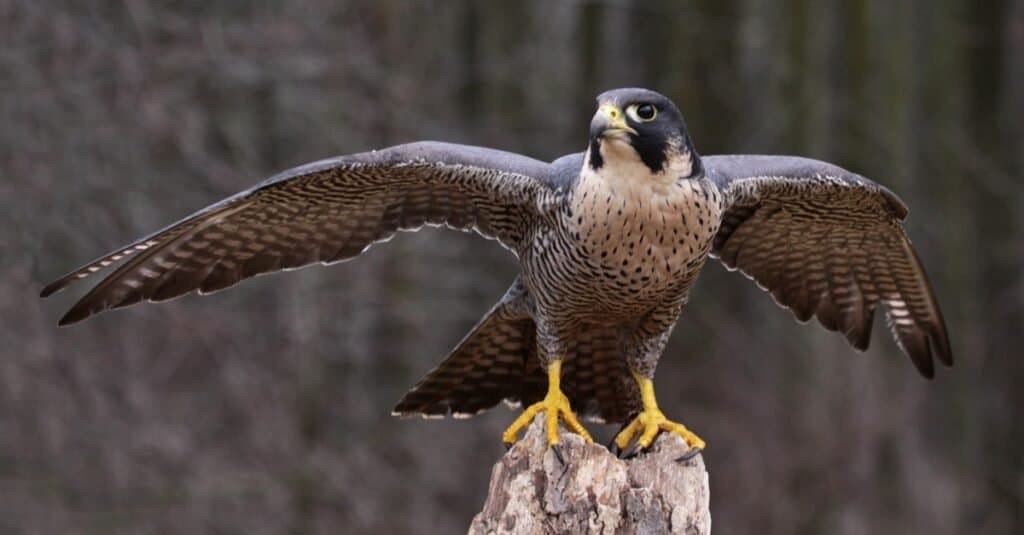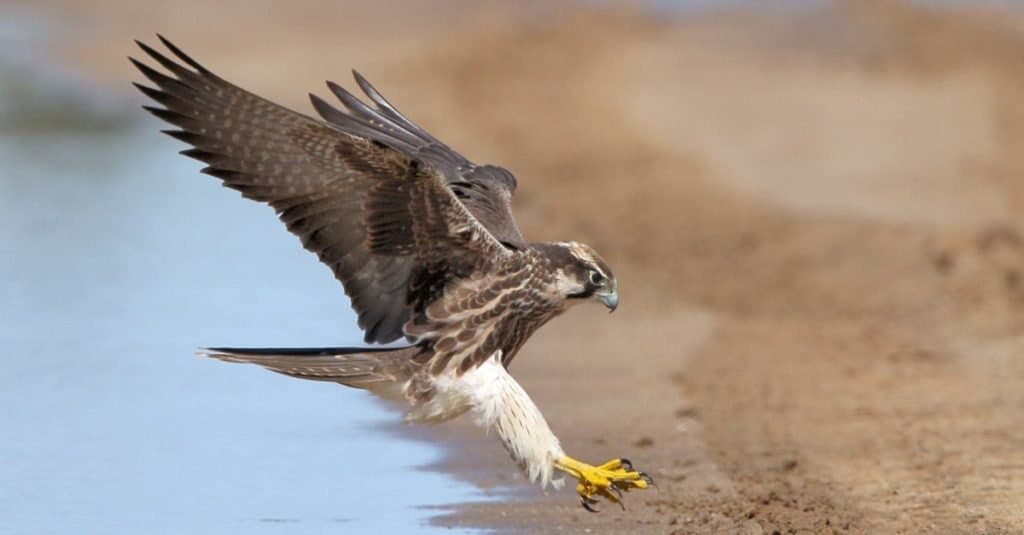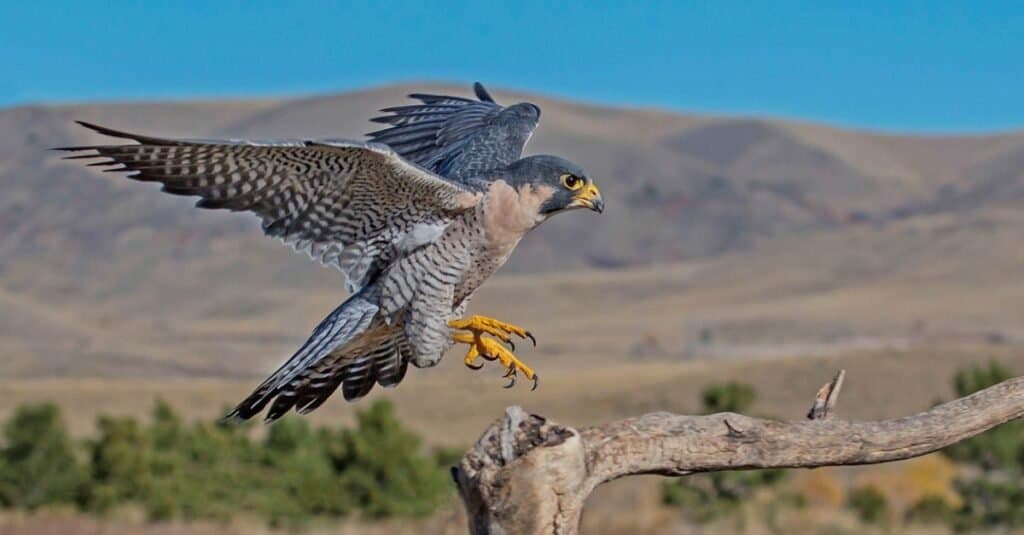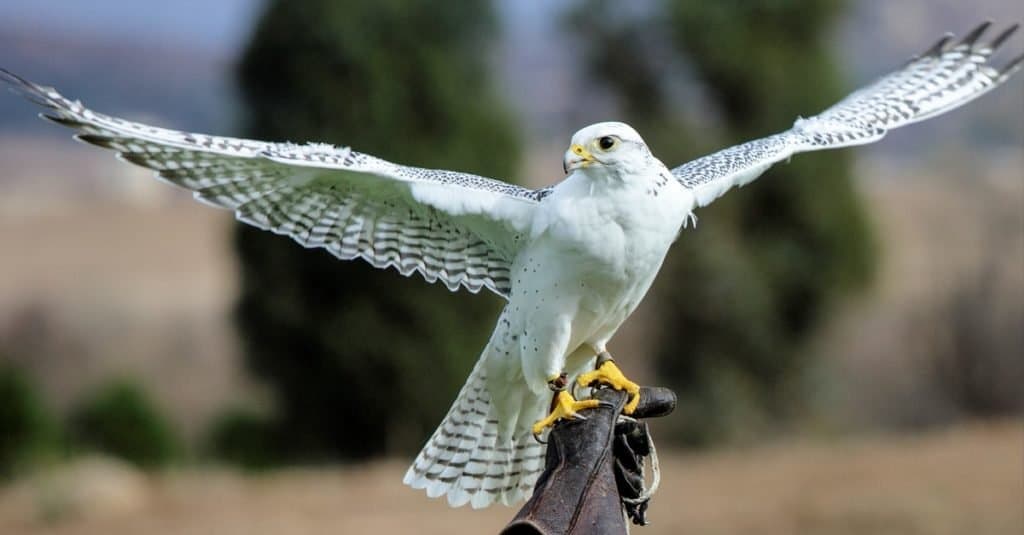Falcons are a type of bird that is related to hawks and eagles. They have a very broad wingspan, which makes them one of the fastest flying birds in the world. Falcons hunt by watching from above for prey on the ground and then swooping down quickly to catch it. Falcons live all over the world and can survive in a variety of habitats such as forests, prairies, or deserts.
Falcons generally eat small mammals such as rabbits or squirrels, but they will also sometimes hunt for larger prey like deer. Some falcon species can even dive at speeds up to 200 miles per hour! Different species will even occasionally feed on other birds, reptiles, fish, or insects.
Want the full scoop on what falcons eat? We’ll dig into their diet, how they hunt, and more!
What do Falcons Eat?

Falcons eat mostly small mammals such as rodents, squirrels, and rabbits.
©Chris Hill/Shutterstock.com
Falcons eat mostly small mammals such as squirrels, rabbits, rats, or gophers in North America. They also enjoy eating birds such as pigeons or quails. Falcons have been known to occasionally take down larger animals like geese or even a fox. In a study done on the diet composition and prey choice of New Zealand falcons, the New Zealand Journal of Ecology found that avian prey (birds) was the main source for falcons during the breeding season, representing 97% of prey frequency!
Falcons are carnivores which means they only eat meat and do not consume plants like other birds.
Falcons usually eat their prey whole, but they will also tear off pieces of flesh to eat. Falcons have very sharp talons, which helps them kill and dismember their prey. Falcons also have a very strong beak which is perfect for tearing meat. How much falcons eat varies by species, but generally they’ll eat 10% of their body weight per day on average and can eat up to 1/3 their body weight during a particularly large feast.
The foods Falcons eat include:
- Deer
- Squirrels
- Rats
- Rabbits.
- Pigeons
- Starlings
- Sparrows.
- Snakes
- Chickens
- Cost
- Eggs
In captivity, falcons eat ground meat from beef, chicken or turkey mixed with a protein-rich supplement.
How do Falcons Hunt Their Prey?

Falcons eat mostly at dusk or dawn when prey is most active
©Neal Cooper/Shutterstock.com
Falcons use their keen eyesight and sharp talons to catch prey. They often perch on high places like trees or telephone poles so they can see their prey better. When they see a potential meal, they fly down quickly and snatch it up with their talons. Falcons are very fast fliers and can reach speeds of up to 200 miles per hour. Falcons usually hunt at dawn or dusk when their prey is most active. Falcons need a lot of energy during hunting which leads to them eating a large percentage of their body weight!
What Impact Does a Falcon’s Diet Have on Other Species?

Peregrine Falcon in flight landing on a branch with wings extended.
©iStock.com/DawnKey
Falcons will eat small birds, reptiles, invertebrates, and mammals, and more. Falcons are not just important to the food chain because they prey on small birds, but in many urban environments often control the populations of animals that can become overwhelming. For example, in many cities, peregrine falcons have become the primary hunters of birds like pigeons.
Do People Keep Falcons as Pets?
Falcons are not domesticated animals. Falcons are typically kept by falconers for hunting purposes.
Falconry is the hunting of wild quarry in its natural state and habitat by means of a trained bird of prey. Falcons have been a part of human hunting for over 4,000 years, from Ancient Greece to medieval Europe. Falcons were especially popular during the time period from the Middle Ages to early 1900s as they provided their owners with prestige as well as practical benefits. There are now only a few falconers who hunt with falcons as patronage from kings and nobility has all but disappeared.
Are Falcons Dangerous to Humans

Falcons aren’t traditionally aggressive towards humans, unless provoked.
©John Hancock/Shutterstock.com
When falcons attack humans, it’s usually because the they were provoked. Falcons should be left alone and not fed or verbally confronted to avoid attacks. In general, falcons will avoid humans and will not attack prey over a certain size. With the largest falcon in the world – the gyrfalcon – only weighing about three pounds, falcons aren’t harmful to humans or other large animals.
The photo featured at the top of this post is © TPCImagery - Mike Jackson/Shutterstock.com
Thank you for reading! Have some feedback for us? Contact the AZ Animals editorial team.






